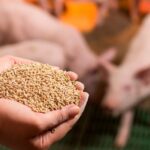Fumaric acid is a strong food preservative used in many foods. This compound helps keep food from going bad. It does this by stopping common bacteria and molds. For example, lactic acid bacteria like Oenococcus oeni and Gluconobacter oxydans from acetic acid bacteria are very sensitive to fumaric acid. They are even more sensitive when the pH is low. The table below shows how different spoilage organisms react to this preservative.
| Spoilage Organism Group | Specific Species | Sensitivity to Fumaric Acid | Notes on Inhibition Conditions |
|---|---|---|---|
| Lactic Acid Bacteria | Oenococcus oeni | More sensitive | Inhibition is stronger at lower pH, high ethanol |
| Lactobacillus species | Less sensitive | ||
| Acetic Acid Bacteria | Gluconobacter oxydans | More sensitive | |
| Acetobacter aceti | Less sensitive | ||
| Biofilm Formation | Various resistant strains | Inhibited | At pH 3.5, ethanol above 8% v/v |
Manufacturers use fumaric acid because it helps food last longer. It also meets tough safety rules.

Fumaric Acid in Food and Beverage Industry
Used as a Preservative
Fumaric acid helps keep food and drinks safe and fresh. Many companies pick fumaric acid because it works in many foods. It stops food from spoiling and helps it last longer. The table below lists types of foods that use this preservative:
| Food & Beverage Category | Examples of Products Using Fumaric Acid as Preservative |
|---|---|
| Fruit Juices & Wines | Fruit juices, wine, wine cocktails |
| Bakery Products | Tortillas, sourdough, rye bread, biscuit dough |
| Desserts & Confectionery | Gelatin desserts, pie fillings, candy, snack foods, breakfast cereals |
| Dairy Products | Chocolate milk, cocoa, eggnog, condensed milk, milk and cream powders, yogurt, cheese |
Fumaric acid in drinks like fruit juice and wine stops bad germs. In bread and dough, it keeps them fresh for more days. Candy and gelatin desserts stay good longer because of it. Dairy foods like chocolate milk and yogurt use it to keep their quality.
Fumaric acid is allowed as a food additive in many places. The European Union calls it E297 and says not to use more than 4000 mg/L. The United States, Australia, and New Zealand also allow it, but do not set a strict limit. This shows fumaric acid is safe to use in foods around the world.
Note: Fumaric acid is also used in animal feed. It helps keep feed fresh and safe for animals.
Additional Functional Roles of Fumaric Acid Beyond Preservation
Fumaric acid does more than just preserve food. It is an acidulant, so it gives foods a tart taste. Many candies use it to make flavors taste right. In drinks, it can make the flavor better and help keep them stable. It also helps control pH, which keeps food safe and good.
The world market for fumaric acid in food and drinks is big. In 2024, food additives made up about 65.5% of the market, worth about USD 436.3 million. People want it because it does many jobs in foods, especially in candy and drinks.
How Fumaric Acid Preserves Food
Antimicrobial Action: How Fumaric Acid Inhibits Bacteria, Yeasts, and Molds
Fumaric acid helps keep food safe by stopping bad microbes. It goes into the cells of bacteria, yeasts, and molds. Inside, it blocks enzymes that help these microbes make energy. Without energy, the microbes cannot grow or multiply. This keeps food fresh and safe for a longer time.
Scientists have tested how well fumaric acid works in real foods. For example, they put a little fumaric acid on sliced ham. The number of harmful bacteria, like Listeria monocytogenes and Salmonella typhimurium, dropped by about ten times compared to ham without it. This shows that fumaric acid can protect food from germs that make people sick.
Fumaric acid also lowers the amount of yeasts and molds. These often spoil food. By stopping them, fumaric acid helps many foods stay safe to eat. This is why food makers trust it to stop spoilage.
Tip: Foods with fumaric acid usually stay fresh and safe longer, even when stored for many days.
Role of Fumaric Acid in Regulating and Lowering pH to Preserve Food
Fumaric acid helps keep food safe by lowering the pH. When added, it makes food more acidic. Most bacteria, yeasts, and molds do not grow well in acid. This is one reason fumaric acid works so well to keep food safe.
Studies show fumaric acid lowers pH better than other acids, like lactic and acetic acids. When used in the same amount, it stops bacteria better than those acids. In wine, it can even slow down some fermentations that other acids cannot. Its strong acid power and ability to stop germs make it a top choice for food safety.
Fumaric acid works best in foods that are already a little acidic. These include fruit juices, yogurt, and some breads. In these foods, it helps them last longer by stopping spoilage. For example, ciabatta bread with fumaric acid stayed soft and fresh for about one more day than bread without it. This extra day helps both stores and people at home.
Food makers use fumaric acid because it fights germs and controls pH well. These things help foods stay safe, taste good, and last longer.
Benefits of Fumaric Acid
Potency and Stability of Fumaric Acid
Fumaric acid stays strong in foods for a long time. It does not take in water from the air. This makes it good for dry mixes and powders. Because of this, flavors stay fresh and work well. Fumaric acid does not break down much during storage. This helps foods keep their quality longer.
Fumaric acid is not the strongest at stopping germs. Some other preservatives work better. The table below shows how fumaric acid compares to others. Benzoic acid and sorbic acid are stronger against bad bacteria at low pH.
| Preservative | Antimicrobial Effectiveness Rank (against E. coli O157:H7 at pH 3.2, anaerobic) |
|---|---|
| Sulfite | 1 (most effective) |
| Benzoic acid | 2 |
| Sorbic acid | 3 |
| Fumaric acid | 4 |
| L- and D-lactic acid | 5 |
| Acetic acid | 6 |
| Malic acid | 7 (least effective) |

Fumaric acid is not the best at killing germs. But it is very stable and keeps food tasting good. Food makers use it when they want food to last and taste the same.
Cost-Effectiveness of Fumaric Acid as a Preservative
Fumaric acid helps companies save money. It gives more sour taste per gram than some other acids. This means companies can use less of it for the same taste. This lowers the cost. It does not soak up water, so it can go right into dry mixes. This helps keep flavor and texture good.
- Fumaric acid gives quick flavor in baked goods and makes dough easier to use.
- In fruit juice drinks, it keeps flavor and color good near pH 3.0.
- It helps candy last longer by keeping it dry and tasty.
- Gelatin desserts and pie fillings get stronger gels and better texture.
Fumaric acid is safe to use in food. The FDA and EFSA say it is safe. Studies show it does not hurt people or animals. Tests on animals found no bad effects. The World Health Organization says it is safe to eat often. It has been used in food and animal feed for many years.
Tip: Fumaric acid makes food taste better and last longer. It also helps companies spend less money.
Safety and Approval
Regulatory Status
Many countries let companies use fumaric acid in food and animal feed. Groups like the EFSA, FDA, and others in Australia and New Zealand check if it is safe. They look at many studies, even ones not published. Experts see how much people eat and what happens in the body. They also check if it can hurt anyone. If new studies come out, they update their rules.
- Agencies look for safety studies in science databases.
- They check reports from food and cosmetics companies.
- Expert groups, like CIR, talk about new research.
- Safety reports and rules are open for everyone to read.
These steps help keep fumaric acid safe for people and animals.
Safe Usage
Tests show fumaric acid is safe in food and animal feed. Animal and human tests found it is not very toxic, even in big amounts. For example, rats and rabbits got a lot but did not get sick. People who took 500 mg every day for a year had no problems with blood or kidneys.
| Species | Study Type | Dose/Concentration | Route | Duration | Observed Effects / Findings |
|---|---|---|---|---|---|
| Rat | Acute toxicity | ~8000 mg/kg bw | Oral | Single dose | Low acute toxicity |
| Rabbit | Acute toxicity | 3600-4800 mg/kg bw | Oral | Single dose | Low acute toxicity |
| Guinea pig | Long-term | 0%, 1%, 10% in diet | Oral | 1 year | No bad effects on growth, fertility, or milk |
| Dog | Long-term | 0, 1, 3, 5% in diet | Oral | 2 years | No bad effects on growth, blood, or organs |
| Human | Observational | 500 mg daily | Oral | 1 year | No toxic effects in blood or kidneys |

Fumaric acid is safe for pigs, chickens, and cows in feed. The table below shows the highest safe amounts and safety margins:
| Animal Category | Maximum Use Level (mg/kg in complete diet) | Margin of Safety |
|---|---|---|
| Pigs and Poultry | 20,000 | About 2 |
| Ruminants | More than pigs and poultry | High enough, no max needed |
| Milk replacers for veal calves and young mammals | 10,000 (provisional) | No margin of safety |
Fumaric acid does not stay in animal meat or milk. So, eating these foods does not add extra risk. Scientists and rule makers agree it is safe when used the right way.
Note: Fumaric acid has a good safety record in food and feed. Agencies keep checking its use to protect everyone’s health.
Manufacturers use this preservative because it keeps food safe.
- It helps food last longer by stopping bad germs and keeping the right acidity.
- Big safety groups say it is safe, so companies and people feel good about using it.
- Many people think it is a natural and safe choice for clean and eco-friendly foods.Picking foods with this preservative usually means picking safe and good quality food.
FAQ
What makes fumaric acid an effective food preservative?
Fumaric acid helps keep food safe. It stops bacteria, yeasts, and molds from growing. This keeps food fresh for a longer time. Many foods use it so they do not spoil fast.
How does fumaric acid help with pH control in foods?
Fumaric acid lowers the pH in foods. When pH is low, bad microbes cannot grow well. This helps keep food safe to eat.
Is fumaric acid safe as a food additive?
Experts say fumaric acid is safe in food. Food safety groups in many countries allow it. Studies show it does not hurt people or animals when used right.
Can fumaric acid improve flavor in confectionery and beverages?
Fumaric acid gives drinks and candy a tart taste. It helps make flavors stronger. Many candies and drinks use it for better taste and to stay fresh.
Why do manufacturers choose fumaric acid for extended shelf life?
Manufacturers use fumaric acid because it keeps food fresh longer. It stops germs and helps food last more days. This is why many companies pick it to preserve food.




